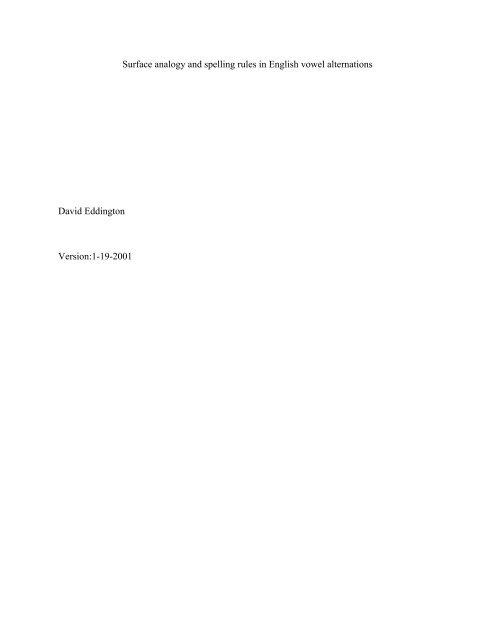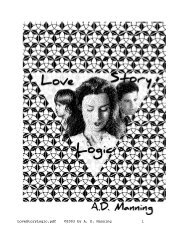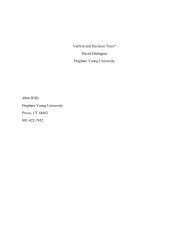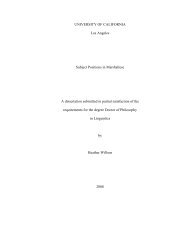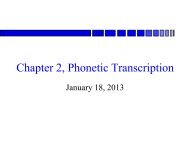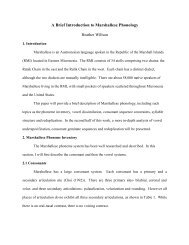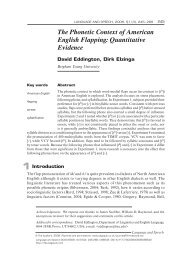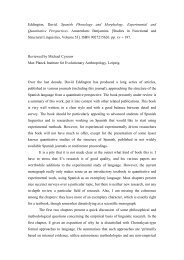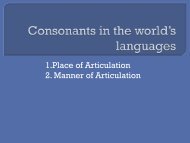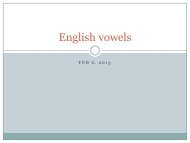Surface analogy and spelling rules in English vowel alternations ...
Surface analogy and spelling rules in English vowel alternations ...
Surface analogy and spelling rules in English vowel alternations ...
You also want an ePaper? Increase the reach of your titles
YUMPU automatically turns print PDFs into web optimized ePapers that Google loves.
David Edd<strong>in</strong>gton<br />
Version:1-19-2001<br />
<strong>Surface</strong> <strong>analogy</strong> <strong>and</strong> <strong>spell<strong>in</strong>g</strong> <strong>rules</strong> <strong>in</strong> <strong>English</strong> <strong>vowel</strong> <strong>alternations</strong>
Abstract<br />
Previous psychol<strong>in</strong>guistic research <strong>in</strong>to the <strong>English</strong> vocalic system suggest that the <strong>vowel</strong><br />
<strong>alternations</strong> [e j ~æ, i j ~g, a j ~I, o w ~a, u w ~v], termed <strong>spell<strong>in</strong>g</strong> rule <strong>alternations</strong>, are psychologically<br />
significant for <strong>English</strong> speakers, <strong>in</strong> that they can <strong>in</strong>fluence the pronunciation of unfamiliar<br />
words. In this paper, the <strong>in</strong>fluence of these salient <strong>alternations</strong> on nonce words <strong>and</strong> neologisms<br />
is assessed. The effect of surface <strong>analogy</strong> on the pronunciation of novel words is also exam<strong>in</strong>ed.<br />
<strong>Surface</strong> <strong>analogy</strong> may be def<strong>in</strong>ed as the <strong>in</strong>fluence exerted by the fully specified surface forms of<br />
the morphemic relatives of a word. It assumes that all allomorphs of a given morpheme have<br />
<strong>in</strong>dividual representation <strong>in</strong> the mental lexicon.<br />
An experiment was performed <strong>in</strong> which the subjects' task was to determ<strong>in</strong>e the<br />
pronunciation of a nonce word or neologism when it was comb<strong>in</strong>ed with a derivational suffix to<br />
form a new word. The potential pronunciations of the new words differed <strong>in</strong> the <strong>vowel</strong>s they<br />
conta<strong>in</strong>ed. A response which conta<strong>in</strong>ed the same <strong>vowel</strong> as the test word was a choice <strong>in</strong> all test<br />
items. Other potential responses conta<strong>in</strong>ed <strong>vowel</strong>s consistent with the <strong>spell<strong>in</strong>g</strong> <strong>rules</strong>, <strong>vowel</strong>s<br />
predicted by surface <strong>analogy</strong>, <strong>and</strong> <strong>vowel</strong>s predicted by neither. The results <strong>in</strong>dicate that the<br />
responses were <strong>in</strong>fluenced, both by the <strong>spell<strong>in</strong>g</strong> rule <strong>alternations</strong>, <strong>and</strong> by the <strong>vowel</strong>s <strong>in</strong> the<br />
morphemic relatives of the test words. However, the <strong>spell<strong>in</strong>g</strong> rule <strong>alternations</strong> exerted more<br />
<strong>in</strong>fluence than did the morphemic relatives.<br />
Key Words: <strong>English</strong> <strong>vowel</strong> shift, <strong>analogy</strong>, morphophonemics.<br />
2
0. Introduction. Vowel <strong>alternations</strong> <strong>in</strong> <strong>English</strong> have been of great <strong>in</strong>terest to phonologists,<br />
especially with<strong>in</strong> the generative paradigm. The abstract nature of the underly<strong>in</strong>g representations<br />
posited by Chomksy <strong>and</strong> Halle (1968), Halle (1977), <strong>and</strong> Halle <strong>and</strong> Mohanan (1985) to account<br />
for the present-day <strong>vowel</strong> <strong>alternations</strong> result<strong>in</strong>g from the Great Vowel Shift prompted a number<br />
of researchers to devise experiments to test the psychologically validity of these <strong>alternations</strong><br />
(Cena, 1978; Jaeger, 1984, 1986; Moskowitz, 1973; Myerson, 1976; Ohala, 1974; Ste<strong>in</strong>berg <strong>and</strong><br />
Krohn, 1975; Templeton, 1979; Wang, 1985; Wang <strong>and</strong> Derw<strong>in</strong>g, 1986, 1994). The consensus<br />
that has emerged from these studies is that only five of the <strong>alternations</strong> result<strong>in</strong>g from the Great<br />
Vowel Shift are psychologically significant for contemporary <strong>English</strong> speakers, namely [e j ~æ,<br />
i j ~g, a j ~I, o w ~a, u w ~v]. That is to say, these <strong>alternations</strong>, <strong>in</strong> contrast to others, were found to play<br />
a significant role <strong>in</strong> experiments <strong>in</strong>volv<strong>in</strong>g concept formation, learn<strong>in</strong>g, memory, <strong>and</strong><br />
pronunciation preference. In addition, they are the most consistent orthographic to <strong>vowel</strong> sound<br />
correspondences <strong>in</strong> <strong>English</strong>. As a result of these studies, Jaeger (1986), <strong>and</strong> Wang <strong>and</strong> Derw<strong>in</strong>g<br />
(1986) suggest that the psychological basis for these <strong>vowel</strong> <strong>alternations</strong> stems from <strong>English</strong><br />
<strong>spell<strong>in</strong>g</strong> <strong>rules</strong>. That is to say, what these five <strong>alternations</strong> have <strong>in</strong> common is that each one<br />
represents what are often taught <strong>in</strong> grammar school as the 'long' <strong>and</strong> 'short' versions of the five<br />
written <strong>vowel</strong>s <strong>in</strong> <strong>English</strong>. For example, the grapheme has two common pronunciations<br />
‘long’[e j ] <strong>and</strong> ‘short’[æ]. 1 The existence of [æ] <strong>in</strong> one word often implies the existence of [e j ] <strong>in</strong> a<br />
morphemic relative (e.g. sane, sanity).<br />
Of course, it may be that these <strong>alternations</strong> are psychologically significant for illiterate<br />
<strong>English</strong> speakers as well, <strong>in</strong> which case, the <strong>spell<strong>in</strong>g</strong> rule hypothesis would not be susta<strong>in</strong>able.<br />
<strong>English</strong> speakers may come to relate the <strong>vowel</strong>s <strong>in</strong> these <strong>alternations</strong> long before, or <strong>in</strong> the<br />
1
absence of formal school<strong>in</strong>g. The large number of related words which demonstrate <strong>spell<strong>in</strong>g</strong> rule<br />
<strong>alternations</strong> (derive~derivative, grave~gravity) may be sufficient to make these pairs of <strong>vowel</strong>s<br />
psychologically salient, <strong>and</strong> allow them to be applied to novel words. The studies cited above<br />
were not designed to demonstrate that explicit tra<strong>in</strong><strong>in</strong>g <strong>in</strong> <strong>English</strong> sound to grapheme<br />
correspondences is responsible for establish<strong>in</strong>g a perceived relationship between the <strong>vowel</strong><br />
<strong>alternations</strong> [e j ~æ, i j ~g, a j ~I, o w ~a, u w ~v]. What they do show is that these five <strong>alternations</strong> are<br />
psychologically relevant for <strong>English</strong> speakers, <strong>in</strong> contrast to several other <strong>vowel</strong> <strong>alternations</strong><br />
discussed <strong>in</strong> the l<strong>in</strong>guistic literature (e.g. [u w ]~[a], lose~lost).<br />
The five <strong>alternations</strong>, whose psychological significance f<strong>in</strong>ds support <strong>in</strong> the literature,<br />
will be referred to as <strong>spell<strong>in</strong>g</strong> rule <strong>alternations</strong> throughout the rema<strong>in</strong>der of this paper, <strong>in</strong> order to<br />
dist<strong>in</strong>guish them from other <strong>vowel</strong> <strong>alternations</strong> that will be discussed. I rema<strong>in</strong> neutral as to the<br />
role orthographic <strong>in</strong>struction has on mak<strong>in</strong>g these <strong>alternations</strong> psychological salient. The<br />
pr<strong>in</strong>cipal purpose of this paper is to demonstrate that <strong>spell<strong>in</strong>g</strong> rule <strong>alternations</strong> play a significant<br />
role <strong>in</strong> determ<strong>in</strong><strong>in</strong>g the pronunciation of novel words. In addition, surface-form <strong>analogy</strong> will be<br />
<strong>in</strong>troduced as another important factor that governs <strong>English</strong> <strong>vowel</strong> <strong>alternations</strong>. <strong>Surface</strong> <strong>analogy</strong><br />
may be def<strong>in</strong>ed as the <strong>in</strong>fluence exerted by the fully specified surface forms of the morphemic<br />
relatives of a word. It assumes that all allomorphs of a given morpheme have <strong>in</strong>dividual<br />
representation <strong>in</strong> the mental lexicon, <strong>and</strong> are not derived from underly<strong>in</strong>g forms. Not only does<br />
surface <strong>analogy</strong> play a part <strong>in</strong> the five <strong>spell<strong>in</strong>g</strong> rule <strong>alternations</strong>, but <strong>in</strong> other <strong>alternations</strong> as well.<br />
Evidence to this effect was found by means of an experiment <strong>in</strong>volv<strong>in</strong>g neologisms <strong>and</strong> nonce<br />
words.<br />
2
1. Ruleless models. In recent years, models which expla<strong>in</strong> phonological <strong>and</strong> morphological<br />
<strong>alternations</strong> by means of underly<strong>in</strong>g representations <strong>and</strong> rule systems are receiv<strong>in</strong>g more <strong>and</strong><br />
more competition from models that <strong>in</strong>volve no <strong>rules</strong> (e.g. Bybee, 1985, 1988, 1995; Rumelhart<br />
<strong>and</strong> McClell<strong>and</strong>, 1986; 2 Stemberger, 1985, 1994; Skousen, 1989, 1992). The idea that all, or at<br />
least most, mono- <strong>and</strong> multimorphemic words have <strong>in</strong>dividual, fully-specified, representation <strong>in</strong><br />
the mental lexicon is central to many of these ruleless models, <strong>and</strong> is supported by a great deal of<br />
empirical evidence (Aitchison, 1994; Alegre <strong>and</strong> Gordon, 1999; Aske, 1990; Baayen, Dijkstra,<br />
<strong>and</strong> Schreuder, 1997; Butterworth, 1983; Bybee, 1995; Derw<strong>in</strong>g, 1990; Edd<strong>in</strong>gton, 2000;<br />
Manelis <strong>and</strong> Tharp, 1977; Marchman, 1997; Nakisa, Plunkett, <strong>and</strong> Hahn, 1998; Ohala <strong>and</strong> Ohala,<br />
1986; Seidenberg, 1992; Seidenberg <strong>and</strong> Bruck, 1990; Sereno <strong>and</strong> Jongman, 1997; Stemberger<br />
<strong>and</strong> MacWh<strong>in</strong>ney, 1988). However, the notion of fully-specified representation is far from<br />
uncontroversial, <strong>and</strong> there is also evidence that some multimorphemic words may be composed<br />
on-l<strong>in</strong>e (e.g. Clahsen et al., 1992; Marcus, 1995; P<strong>in</strong>ker, 1991, 1997; P<strong>in</strong>ker <strong>and</strong> Pr<strong>in</strong>ce, 1994;<br />
Ullman, 1999).<br />
The notion that <strong>in</strong>dividual word tokens are stored <strong>in</strong> their surface phonetic form is<br />
supported by psychol<strong>in</strong>guistic evidence as well (Bybee, 1994; Gold<strong>in</strong>ger, 1997; Palmeri,<br />
Gold<strong>in</strong>ger, <strong>and</strong> Pisoni, 1993; Pisoni, 1997). In fact, storage of surface forms may go beyond<br />
<strong>in</strong>dividual words <strong>and</strong> encompass recurrent word comb<strong>in</strong>ations as well as entire phrases (Bod,<br />
1998; Bybee, 1999; Pawley <strong>and</strong> Syder, 1983). In essence, many of the central elements of<br />
generative phonological theory, such as underly<strong>in</strong>g representations, derivational <strong>rules</strong>, <strong>and</strong> the<br />
cycle are unnecessary <strong>in</strong> a model that relates fully specified surface forms to each other, <strong>in</strong>stead<br />
of to more abstract underly<strong>in</strong>g forms (Burzio, 1996). In addition, there is also grow<strong>in</strong>g doubt as<br />
3
to the adequacy of these mechanisms from a theoretical st<strong>and</strong>po<strong>in</strong>t (Cole, 1995; Cole <strong>and</strong><br />
Hualde, 1998; Steriade, 1995).<br />
Of course, even a ruleless model of language must be able to expla<strong>in</strong> how new <strong>and</strong><br />
previously unseen words are produced <strong>and</strong> understood. Nevertheless, it is possible to expla<strong>in</strong> the<br />
productive aspect of language without recourse to overly abstract underly<strong>in</strong>g forms. Skousen's<br />
(1989, 1992) analogical model seems particularly promis<strong>in</strong>g <strong>in</strong> this regard. In any event, if fully<br />
specified storage of most words is a reality, it follows that the surface forms themselves can<br />
<strong>in</strong>fluence the production of new words. In the process of word formation, the <strong>in</strong>fluence exerted<br />
by the surface forms of the morphemic relatives of a word will be referred to as <strong>Surface</strong><br />
Analogy. <strong>Surface</strong> Analogy bears some resemblance to a number of recent proposals.<br />
2.0 Constra<strong>in</strong>ts <strong>in</strong>vok<strong>in</strong>g surface <strong>analogy</strong>.<br />
2.1. Lexical conservatism. In phonology, lexical conservatism may be def<strong>in</strong>ed as the tendency<br />
to avoid produc<strong>in</strong>g allomorphs whose phonological shape is novel <strong>and</strong> unattested. Accord<strong>in</strong>g to<br />
Steriade (1997:1):<br />
Phonological processes are, under certa<strong>in</strong> circumstances, blocked from creat<strong>in</strong>g novel<br />
phonological variants to a listed stem. Rather than generat<strong>in</strong>g new allomorphs, speakers<br />
recycle already exist<strong>in</strong>g ones, when none of the listed allomorphs gives full satisfaction<br />
to the applicable phonological <strong>and</strong> morphosyntactic conditions. 3<br />
An example of lexical conservatism is provided by Steriade (1997). She conducted an<br />
experiment <strong>in</strong> which subjects were asked to determ<strong>in</strong>e the stress placement <strong>in</strong> novel adjectives<br />
4
end<strong>in</strong>g <strong>in</strong> -able that are based on a verbal forms (e.g. eradicable from eradicate). Most of these<br />
adjectives must be considered neologisms, which means that their stress pattern was not merely<br />
accessed from the mental lexicon. The results <strong>in</strong>dicate that the stress pattern of the verbal form<br />
was shifted to the right <strong>in</strong> an adjectival form only if stress also falls on that syllable <strong>in</strong> a<br />
morphemic relative. For example, <strong>in</strong> góvern, góvernor, góvernment, stress always falls on the<br />
first syllable. There are no allomorphs with the pattern *govérn-. In cases such as these, the<br />
stress on the adjective was not shifted to the right as phonotactic constra<strong>in</strong>ts would predict. This<br />
yielded adjectives such as góvernable, <strong>and</strong> not *govérnable. On the other h<strong>and</strong>, many verbs<br />
such as démonstrate have morphemic relatives with stress fall<strong>in</strong>g on the syllable to the right (i.e.<br />
demónstrative). In these cases, subjects preferred stress that was shifted to the right <strong>in</strong> the<br />
adjectival form, as <strong>in</strong> demónstrable. 4 Accord<strong>in</strong>g to lexical conservatism, the existence of<br />
demónstrative allows stress to fall on the second syllable <strong>in</strong> demónstrable, while the lack of any<br />
allomorph with *govérn- is responsible for the word <strong>in</strong>itial stress of góvernable.<br />
Of course, the results of Steriade’s study may be attributed to a number of other forces<br />
besides lexical conservatism. However, a discussion of possible alternative explanations is<br />
beyond the scope of the present study. Steriade’s study of neologisms is merely cited as an<br />
illustration of her conception of lexical conservatism as a constra<strong>in</strong>t <strong>in</strong> morphophonology.<br />
The notion of surface <strong>analogy</strong> as used <strong>in</strong> the present paper differs from Steriade's (1999a)<br />
view of lexical conservatism <strong>in</strong> one important way. Lexical conservatism is essentially a<br />
block<strong>in</strong>g mechanism. If a general phonological process would apply <strong>in</strong> such a way as to<br />
produce an allomorph that is unattested <strong>in</strong> the language, that process will under certa<strong>in</strong><br />
conditions be blocked by lexical conservatism. <strong>Surface</strong> Analogy, on the other h<strong>and</strong>, merely<br />
5
implies that the phonetic make-up of the exist<strong>in</strong>g allomorphs of a base form may <strong>in</strong>fluence the<br />
production of another allomorph of that base form; the creation of unattested allomorphs is<br />
disfavored. <strong>Surface</strong> Analogy does not entail block<strong>in</strong>g.<br />
2.2. Transderivational identity constra<strong>in</strong>ts. In SPE (Chomsky <strong>and</strong> Halle 1968), <strong>in</strong> order for the<br />
phonological shape of one word to affect that of a morphemic relative, the notion of cyclicity<br />
was employed <strong>in</strong> which one related word was embedded <strong>in</strong> another (e.g. [[condense]ation].<br />
With<strong>in</strong> the framework of Optimality Theory, the work formerly done by the cycle is carried out<br />
by means of a number of constra<strong>in</strong>ts which are also transderivational <strong>in</strong> nature. Many of these<br />
are extensions of Correspondence Theory (McCarthy <strong>and</strong> Pr<strong>in</strong>ce, 1994a, b). The essence of<br />
these constra<strong>in</strong>ts is that the output of GEN may be constra<strong>in</strong>ed by the surface phonetic form of<br />
<strong>in</strong>dependently exist<strong>in</strong>g words (Benua, 1995; Burzio, 1996; McCarthy, 1995). For example,<br />
Kenstowicz (1996) def<strong>in</strong>es Base-Identity <strong>in</strong> this way: "Given an <strong>in</strong>put structure [X Y] output<br />
c<strong>and</strong>idates are evaluated for how well they match [X] <strong>and</strong> [Y] if the latter occur as <strong>in</strong>dependent<br />
words." In a similar manner, the Uniform Exponence constra<strong>in</strong>t gives preference to<br />
morphological relatives that share surface traits so that paradigms are kept maximally uniform<br />
(Kenstowicz, 1998).<br />
It would be possible to consider <strong>Surface</strong> Analogy as a variant <strong>in</strong>stantiation of a<br />
transderivational constra<strong>in</strong>t <strong>in</strong> Optimality Theory. However, the two <strong>in</strong>fluences that will be<br />
discussed, <strong>Surface</strong> Analogy <strong>and</strong> the <strong>alternations</strong> embodied <strong>in</strong> the <strong>spell<strong>in</strong>g</strong> <strong>rules</strong>, would not allow<br />
one to determ<strong>in</strong>e a s<strong>in</strong>gle unique constra<strong>in</strong>t rank<strong>in</strong>g between the two (e.g. <strong>Surface</strong> Analogy
3. <strong>Surface</strong> <strong>analogy</strong> <strong>in</strong> studies on the <strong>English</strong> <strong>vowel</strong> shift. One of the earliest experimental<br />
techniques which was applied to the <strong>vowel</strong> shift question were morpheme comb<strong>in</strong>ation<br />
experiments. In this type of experiment, the subjects were given an exist<strong>in</strong>g word <strong>and</strong> a suffix<br />
<strong>and</strong> asked to comb<strong>in</strong>e them to construct a neologism (Ohala, 1974; Ste<strong>in</strong>berg <strong>and</strong> Krohn, 1975).<br />
For <strong>in</strong>stance, subjects were asked to comb<strong>in</strong>e maze <strong>and</strong> the suffix -ic to form the word mazic.<br />
The expected outcome would be [me j z] | [mæzIk]. However, the most common way subjects<br />
h<strong>and</strong>led these questions was to leave the <strong>vowel</strong> unchanged (i.e. [me j z] | [me j zIk]). Accord<strong>in</strong>g<br />
to <strong>Surface</strong> Analogy, this occurs because the use of [mæz-] would entail the creation of a novel<br />
allomorph. The unchanged form, on the other h<strong>and</strong>, is preferred s<strong>in</strong>ce [me j z-] is the only attested<br />
allomorph.<br />
Myerson (1976) performed a similar experiment with nonce words <strong>and</strong> obta<strong>in</strong>ed the<br />
same results. The fact that nonce words, such as tr[e j ]ve, usually yielded unchanged forms, such<br />
as tr[e j ]vity, <strong>in</strong>stead of tr[æ]vity, can be expla<strong>in</strong>ed by the fact that the nonce form tr[e j ]v- is the<br />
only allomorph available to work with. Generat<strong>in</strong>g a word such as tr[æ]vity entails produc<strong>in</strong>g<br />
an unattested allomorph <strong>in</strong> violation of <strong>Surface</strong> Analogy.<br />
Of course, many experiments did produce results that are consistent with the <strong>English</strong><br />
Spell<strong>in</strong>g Rule, <strong>in</strong> violation of <strong>Surface</strong> Analogy. However, these studies were designed <strong>in</strong> such a<br />
way as to elim<strong>in</strong>ate <strong>Surface</strong> Analogy as a factor. For example, <strong>in</strong> another experiment by<br />
Myerson (1976) the subjects' task was to choose between two different pronunciations of various<br />
nonce words (e.g. tr[e j ]ve) that had been affixed with -ity <strong>and</strong> -ical. Yet, neither of the two<br />
possible responses conta<strong>in</strong>ed the same <strong>vowel</strong> as the unaffixed nonce word (e.g. tr[æ]vity,<br />
tr[e]vity. A similar situation exists <strong>in</strong> Wang <strong>and</strong> Derw<strong>in</strong>g's (1994) studies. Subjects were<br />
7
equired to choose a response whose <strong>vowel</strong> differed from that of the base word presented to<br />
them. In a study that uses nonce words, the only allomorph available to the subjects is that of the<br />
experimental nonce word. Therefore, <strong>Surface</strong> Analogy predicts that affixation of the nonce word<br />
will not result <strong>in</strong> a derived word with a different <strong>vowel</strong>. However, Myerson's <strong>and</strong> Wang <strong>and</strong><br />
Derw<strong>in</strong>g's subjects did not have the option of leav<strong>in</strong>g the <strong>vowel</strong> unchanged. Hence, they had to<br />
adopt other strategies for determ<strong>in</strong><strong>in</strong>g which <strong>vowel</strong> to choose. Wang <strong>and</strong> Derw<strong>in</strong>g suggest that<br />
these strategies <strong>in</strong>cluded us<strong>in</strong>g the Spell<strong>in</strong>g Rule <strong>and</strong> analogiz<strong>in</strong>g on exist<strong>in</strong>g words.<br />
A number of other experiments were carried out to test the psychological validity of<br />
certa<strong>in</strong> <strong>vowel</strong> shifts. For example, Jaeger (1984), Moskowitz (1973), <strong>and</strong> Wang <strong>and</strong> Derw<strong>in</strong>g<br />
(1986) carried out experiments which utilized a concept formation technique. Cena's (1978)<br />
study <strong>in</strong>volved the learnability of nonce words with different <strong>alternations</strong>, <strong>and</strong> Myerson (1976)<br />
tested the effect of the <strong>alternations</strong> on the recall of nonce words that had been memorized. These<br />
studies provide valid positive evidence about the psychological validity of the <strong>alternations</strong><br />
embodied <strong>in</strong> the Spell<strong>in</strong>g Rule. However, they give no <strong>in</strong>sight <strong>in</strong>to the effect of <strong>Surface</strong> Analogy<br />
on <strong>vowel</strong> <strong>alternations</strong>. The experimental paradigms employed simply do not allow for possible<br />
production of an exist<strong>in</strong>g versus a non-exist<strong>in</strong>g allomorph. Therefore, it should be evident these<br />
studies do not address, (nor do they <strong>in</strong>tend to address), the effect that <strong>Surface</strong> Analogy has on<br />
<strong>vowel</strong> <strong>alternations</strong>.<br />
4. The experiment. The purpose of the present experiment is to determ<strong>in</strong>e the effect that the<br />
<strong>English</strong> Spell<strong>in</strong>g Rule <strong>and</strong> <strong>Surface</strong> Analogy have on <strong>vowel</strong> preferences <strong>in</strong> derived neologisms<br />
<strong>and</strong> nonce words.<br />
8
4.1. Subjects. Subjects were all undergraduate college students who received extra credit <strong>in</strong> a<br />
course for their participation <strong>in</strong> the study. All were native speakers of American <strong>English</strong>.<br />
Twenty-two males <strong>and</strong> 19 females participated. Ages ranged from 18 to 25 years of age with a<br />
median age of 21.<br />
4.2. Procedure. The questionnaire consisted of 63 test items: 21 nonce items <strong>and</strong> 42 neologisms.<br />
The order the items appeared <strong>in</strong> the questionnaire was determ<strong>in</strong>ed at r<strong>and</strong>om, <strong>and</strong> each item was<br />
presented <strong>in</strong> the format of a short sentence or paragraph. For example,<br />
"Of course she's beautiful," he thought, but he still couldn't st<strong>and</strong> her denague<br />
attitude. If it weren't for her _____, he had even considered ask<strong>in</strong>g her out.<br />
Dur<strong>in</strong>g the experimental session, subjects read along silently as the experimenter read the<br />
context paragraph for each item out loud. 5 Afterwards, the experimenter read the three possible<br />
responses, <strong>and</strong> the subjects marked a letter correspond<strong>in</strong>g to their preferred response. The<br />
subjects saw no orthographic representation of the responses. All context paragraphs <strong>and</strong><br />
responses were read through twice <strong>in</strong> their entirety. The experimental session lasted about 45<br />
m<strong>in</strong>utes.<br />
Subjects were <strong>in</strong>formed that their task was to choose the response that sounded the most<br />
correct to them. They were <strong>in</strong>formed that the word that fit <strong>in</strong> the blank was related to the<br />
underl<strong>in</strong>ed word <strong>in</strong> the paragraph. Given the tendency to respond without chang<strong>in</strong>g the root<br />
<strong>vowel</strong>, which was observed <strong>in</strong> previous experiments (Myerson, 1976; Ohala, 1974; Ste<strong>in</strong>berg<br />
<strong>and</strong> Krohn, 1975), the subjects were told to choose the option with the same <strong>vowel</strong> sound that<br />
the underl<strong>in</strong>ed word conta<strong>in</strong>ed only if the other options were completely unacceptable. These<br />
9
<strong>in</strong>structions were given both <strong>in</strong> writ<strong>in</strong>g <strong>and</strong> orally. It was hoped that by follow<strong>in</strong>g these<br />
<strong>in</strong>structions, the effects of <strong>Surface</strong> Analogy as well as those of the Spell<strong>in</strong>g Rule would be<br />
manifest.<br />
4.3. Stimulus materials. The 63 test items fall <strong>in</strong>to one of six categories. For the sake of clarity,<br />
the categories <strong>and</strong> the specific questionnaire items <strong>in</strong> each category are presented <strong>in</strong> the<br />
follow<strong>in</strong>g section along with the results for each category. Derived forms were made with the<br />
addition of the suffixes -ify, -ical, -atory, -tion, -ative, -ic, ity, or -ification. These suffixes were<br />
chosen because they generally ‘trigger’ a change of <strong>vowel</strong> quality, although the change is not<br />
without exceptions (e.g. obese ~ obesity). In addition, these suffixes were among those used <strong>in</strong><br />
the previously cited studies on <strong>vowel</strong> <strong>alternations</strong>. The order <strong>in</strong> which the test items <strong>and</strong> possible<br />
responses were presented was r<strong>and</strong>omized <strong>in</strong> the questionnaire.<br />
4.4. Results <strong>and</strong> Discussion.<br />
4.4.1. Nonce words with [e j , i j , a j , o w ]. In a previous study (Myerson, 1976), subjects<br />
overwhelm<strong>in</strong>g preferred to leave the <strong>vowel</strong> of a nonce word unchanged when they comb<strong>in</strong>ed it<br />
with a suffix to form a new word. <strong>Surface</strong> Analogy suggests that s<strong>in</strong>ce no other allomorphs exist<br />
for nonce words, the tendency will be to leave the stem <strong>vowel</strong> unchanged. However, the present<br />
study differs from Meyerson's <strong>in</strong> that the subjects were given possible outcomes to choose from.<br />
They were also <strong>in</strong>structed to choose a derived word with a different <strong>vowel</strong> unless chang<strong>in</strong>g<br />
<strong>vowel</strong> would result <strong>in</strong> a word that was completely unacceptable. The nonce items <strong>in</strong> (1) were<br />
10
<strong>in</strong>cluded to test whether the subjects had adopted the strategy of consider<strong>in</strong>g possible changes,<br />
<strong>in</strong>stead of merely leav<strong>in</strong>g the <strong>vowel</strong> unchanged.<br />
(1) Nonce words conta<strong>in</strong><strong>in</strong>g [e j , i j , a j , o w ] 6 <strong>in</strong> stressed position (n=12).<br />
Example: denague > den_guity<br />
Possible Responses:<br />
1-No change: den[e j ]guity.<br />
2-The lax <strong>vowel</strong> [æ, g, I, a] predicted by the Spell<strong>in</strong>g Rule: den[æ]guity.<br />
3-Another lax <strong>vowel</strong> as a distractor: den[v]guity.<br />
The comb<strong>in</strong>ed number of responses for all 12 items (Table 1) shows an overwhelm<strong>in</strong>g<br />
tendency toward the lax <strong>vowel</strong>s predicted by the Spell<strong>in</strong>g Rule over the no change condition <strong>and</strong><br />
distractor responses (χ 2 (2)=307.840, p < .001):<br />
++Insert Table 1 here++<br />
The ability of the Spell<strong>in</strong>g Rule to affect nonce words confirms the f<strong>in</strong>d<strong>in</strong>gs by Wang <strong>and</strong><br />
Derw<strong>in</strong>g (1994), <strong>and</strong> those the study by Myerson (1976) <strong>in</strong> which the no change condition was<br />
not an option. At the same time, it demonstrates that the subjects were will<strong>in</strong>g to consider<br />
responses with <strong>vowel</strong>s other than those that appeared <strong>in</strong> the test words. This means that the<br />
<strong>Surface</strong> Analogy did not negate the <strong>in</strong>fluence of the Spell<strong>in</strong>g Rule, as may have been the case <strong>in</strong><br />
the previous studies.<br />
4.4.2. Neologisms with [æ, g, a, o j , æ w ]. The reason for <strong>in</strong>clud<strong>in</strong>g these items was to determ<strong>in</strong>e<br />
the effect that <strong>Surface</strong> Analogy has on <strong>vowel</strong> <strong>alternations</strong> apart from any possible <strong>in</strong>fluence due<br />
to the Spell<strong>in</strong>g Rule. To this end, n<strong>in</strong>e test items were <strong>in</strong>cluded whose morphemic relatives<br />
11
conta<strong>in</strong> <strong>vowel</strong>s not consistent with the Spell<strong>in</strong>g Rule (e.g. [a]~[æ] <strong>in</strong> coffee~caffe<strong>in</strong>e; [g]~[v] <strong>in</strong><br />
compel~compulsion, compulsive). It is important to note that the subjects did not see the<br />
morphemic relatives ( e.g. caffe<strong>in</strong>e) of the test word ( e.g. coffee).<br />
(2) Neologisms conta<strong>in</strong><strong>in</strong>g the non-<strong>spell<strong>in</strong>g</strong> rule <strong>vowel</strong>s [æ, g, a, o j , æ w ] <strong>in</strong> stressed position<br />
(n=9).<br />
Example: coffee > c_ffify. Related word: caffe<strong>in</strong>e.<br />
Possible Responses:<br />
1-No change: c[a]ffify.<br />
2-Vowel from related word predicted by <strong>Surface</strong> Analogy: c[æ]ffify.<br />
3-Another lax <strong>vowel</strong> as a distractor: c[v]ffify.<br />
Any preference for the <strong>vowel</strong> <strong>in</strong> the morphemic relative would be attributed to <strong>Surface</strong> Analogy.<br />
A Chi-squared analysis <strong>in</strong>dicates that the distribution of the responses (Table 2) is not<br />
r<strong>and</strong>om (χ 2 (2)=55.918, p < .001). Moreover, responses that favor the <strong>vowel</strong> of the morphemic<br />
relative are significantly more numerous than responses <strong>in</strong> which the <strong>vowel</strong> was not changed <strong>in</strong><br />
the suffixed form (χ 2 (1)=17.337, p < .001).<br />
++Insert Table 2 here+<br />
Upon compar<strong>in</strong>g the outcomes of (1) <strong>and</strong> (2), it appears that the Spell<strong>in</strong>g Rule wielded<br />
more <strong>in</strong>fluence on the choice of response than <strong>Surface</strong> Analogy did. This is to be expected. The<br />
Spell<strong>in</strong>g Rule generally have their locus <strong>in</strong> a s<strong>in</strong>gle letter (or phoneme, Wang, 1985). Therefore,<br />
when a subject is asked to choose what <strong>vowel</strong> sounds most correct when a word conta<strong>in</strong><strong>in</strong>g <br />
is suffixed, a number of th<strong>in</strong>gs could happen. The subject could make conscious use of the fact<br />
that [æ] is the 'short' version of [e j ]. This strategy was reported by several subjects <strong>in</strong> previous<br />
12
experiments (Jaeger, 1984; Wang, 1985; Wang <strong>and</strong> Derw<strong>in</strong>g, 1986).<br />
A less conscious process is also possible. The high <strong>in</strong>cidence of <strong>spell<strong>in</strong>g</strong> rule <strong>alternations</strong><br />
among <strong>English</strong> words could lead to a situation <strong>in</strong> which [e j ] <strong>and</strong> [æ] are l<strong>in</strong>ked associatively <strong>in</strong><br />
the m<strong>in</strong>d (Wang, 1985). Whenever one is heard or produced, the other is partially activated as<br />
well. Read<strong>in</strong>g the letter <strong>in</strong> certa<strong>in</strong> contexts could activate both [e j ] <strong>and</strong> [æ] at the same time.<br />
Regardless of the process, the po<strong>in</strong>t is that <strong>in</strong> order to choose the other member of the <strong>spell<strong>in</strong>g</strong><br />
rule pair, noth<strong>in</strong>g is needed beyond the graphemic or phonological <strong>in</strong>formation about the <strong>vowel</strong>.<br />
The situation is very different as far as the items <strong>in</strong> (2) are concerned. There, the<br />
extremely common <strong>vowel</strong> <strong>alternations</strong> of the Spell<strong>in</strong>g Rule cannot come <strong>in</strong>to play. Instead, the<br />
morphemic relatives of the test word are the crucial factor. For example, coffee will yield<br />
c[æ]ffify (def<strong>in</strong>ition given <strong>in</strong> test paragraph: to make taste like coffee) if the word caffe<strong>in</strong>e or<br />
caffe<strong>in</strong>ate is l<strong>in</strong>ked to it <strong>in</strong> the mental lexicon. This l<strong>in</strong>k<strong>in</strong>g allows caffe<strong>in</strong>e to be consciously<br />
accessed or unconsciously activated. In this manner, its stem <strong>vowel</strong> is available to be used <strong>in</strong> the<br />
neologism accord<strong>in</strong>g to <strong>Surface</strong> Analogy. What this means is that the effect of <strong>Surface</strong> Analogy<br />
is dependent on a subject's hav<strong>in</strong>g associated the relevant words <strong>in</strong> the mental lexicon. Exactly<br />
what words are associated <strong>in</strong> memory is more likely to vary from person to person than are the<br />
<strong>vowel</strong>s that are associated via the Spell<strong>in</strong>g Rule. This may expla<strong>in</strong> why the results for the items<br />
<strong>in</strong> (2) show less <strong>in</strong>fluence when compared with those <strong>in</strong> (1).<br />
4.4.3. Nonce with [æ, g, a, o j , æ w ]. It is conceivable that the results from the neologisms <strong>in</strong> (2)<br />
are not actually due to <strong>Surface</strong> Analogy. Instead, the subjects may have perceived some sort of<br />
similarity between the <strong>vowel</strong>s <strong>in</strong> the test words <strong>and</strong> the <strong>vowel</strong>s of the preferred responses. In<br />
13
other words, access or activation of the test words' morphemic relatives may not have <strong>in</strong>fluenced<br />
the outcome. For this reason, these n<strong>in</strong>e nonce items were <strong>in</strong>cluded as controls for their<br />
respective neologisms <strong>in</strong> (2). Each nonce word is matched to a specific neologism from (2) <strong>in</strong><br />
terms of the stressed <strong>vowel</strong> <strong>in</strong> the unaffixed word, the suffix used <strong>in</strong> the response, <strong>and</strong> the <strong>vowel</strong>s<br />
<strong>in</strong> the three responses. Response A corresponds to the 'Vowel <strong>in</strong> Other Allomorph' response <strong>in</strong><br />
(2), <strong>and</strong> Response B corresponds to the 'Distractor Response' <strong>in</strong> (2):<br />
(3) Control nonce words conta<strong>in</strong><strong>in</strong>g the non-<strong>spell<strong>in</strong>g</strong> rule <strong>vowel</strong>s [æ, g, a, o j , æ w ] <strong>in</strong> stressed<br />
position (n=9).<br />
Example: prolot > prol_tify, (matched to coffee > c_ffify <strong>in</strong> (1)).<br />
Possible Responses:<br />
1-No change: prol[a]tify<br />
2-Another lax <strong>vowel</strong> as a distractor: prol[æ]tify.<br />
3-Another lax <strong>vowel</strong> as a distractor: prol[v]tify.<br />
In Table 3, it is evident that the choice of responses to these nonce items is r<strong>and</strong>om (χ 2<br />
(2)=2.779, p < .1), <strong>in</strong> clear contrast to the outcome <strong>in</strong> (2). Therefore, the hypothesis that <strong>Surface</strong><br />
Analogy is responsible for the results <strong>in</strong> (2) is further supported.<br />
++Insert Table 3 here++<br />
4.4.4. Neologisms <strong>in</strong>fluenced toward the same outcome by the Spell<strong>in</strong>g Rule <strong>and</strong> <strong>Surface</strong><br />
Analogy. To this po<strong>in</strong>t, the effects of <strong>Surface</strong> Analogy <strong>and</strong> the Spell<strong>in</strong>g Rule have been<br />
considered separately. Here the additive effects of the Spell<strong>in</strong>g Rule <strong>and</strong> <strong>Surface</strong> Analogy are<br />
tested. Twelve test items were chosen that conta<strong>in</strong>ed [e j , i j , a j , o w , u w ] <strong>in</strong> stressed position, <strong>and</strong><br />
14
were thus subject to be<strong>in</strong>g <strong>in</strong>fluenced by the Spell<strong>in</strong>g Rule. In addition, each test word has at<br />
least one morphemic relative conta<strong>in</strong><strong>in</strong>g a <strong>vowel</strong> consistent with the Spell<strong>in</strong>g Rule (e.g.<br />
Palest<strong>in</strong>e, Palest<strong>in</strong>ian). This allows <strong>Surface</strong> Analogy to become an <strong>in</strong>fluenc<strong>in</strong>g factor as well.<br />
(4) Neologisms conta<strong>in</strong><strong>in</strong>g [e j , i j , a j , o w , u w ] <strong>in</strong> stressed position, that also have morphemic<br />
relatives with the correspond<strong>in</strong>g lax <strong>vowel</strong>s [æ, g, I, a, v] predicted by the Spell<strong>in</strong>g Rule<br />
(n=12).<br />
Example: <strong>in</strong>tervene > <strong>in</strong>terv_natory. Related word: <strong>in</strong>tervention.<br />
Possible Responses:<br />
1-No change: <strong>in</strong>terv[i j ]natory.<br />
2-Lax <strong>vowel</strong> [æ, g, I, a, v] predicted by the Spell<strong>in</strong>g Rule <strong>and</strong> <strong>Surface</strong> Analogy:<br />
<strong>in</strong>terv[g]natory.<br />
3-Another lax <strong>vowel</strong> as a distractor: <strong>in</strong>terv[æ]natory.<br />
As seen <strong>in</strong> Table 4, the comb<strong>in</strong>ation of these two factors results <strong>in</strong> extremely strong preference<br />
for the lax Spell<strong>in</strong>g Rule <strong>and</strong> <strong>Surface</strong> Analogy <strong>vowel</strong>s (χ 2 (2)=527.023, p < .001):<br />
++Insert table 4 here++<br />
These results are important s<strong>in</strong>ce previous studies did not consider the <strong>in</strong>fluence that morphemic<br />
relatives with <strong>spell<strong>in</strong>g</strong> rule allomorphy can have on the formation of neologisms, <strong>in</strong> addition to<br />
that of the Spell<strong>in</strong>g Rule themselves.<br />
4.4.5. Neologisms <strong>in</strong>fluenced toward different outcomes by the Spell<strong>in</strong>g Rule <strong>and</strong> <strong>Surface</strong><br />
Analogy. Each of these test words conta<strong>in</strong> the tense <strong>vowel</strong>s associated with the Spell<strong>in</strong>g Rule:<br />
[e j , i j , a j , o w , u w ]. However, none of the words' morphemic relatives demonstrate a <strong>vowel</strong> change<br />
15
(e.g. nude~nudity):<br />
(5) Neologisms conta<strong>in</strong><strong>in</strong>g [e j , i j , a j , o w , u w ] <strong>in</strong> stressed position, all of whose morphemic<br />
relatives conta<strong>in</strong> these same <strong>vowel</strong>s (n=12).<br />
Example: survive > surv_vative. Related word: survival.<br />
Possible Responses:<br />
1-No change predicted by <strong>Surface</strong> Analogy: surv[a j ]vative.<br />
2-Lax <strong>vowel</strong> [æ, g, I, a, v] predicted by the Spell<strong>in</strong>g Rule: surv[I]vative.<br />
3-Another lax <strong>vowel</strong> as a distractor: surv[g]vative.<br />
Words of this sort were tested by Ste<strong>in</strong>berg <strong>and</strong> Krohn (1975) <strong>and</strong> Ohala (1974). 7 They found a<br />
strong tendency to leave the <strong>vowel</strong> unchanged <strong>in</strong> the suffixed words. Accord<strong>in</strong>g to <strong>Surface</strong><br />
Analogy, this is due to the <strong>in</strong>fluence of the morphemic relatives which conta<strong>in</strong> the same <strong>vowel</strong> as<br />
the test words. Responses to the 12 test words <strong>in</strong> the present study produced the results <strong>in</strong> Table<br />
5 (χ 2 (2) =135.230, p < .001):<br />
++Insert Table 5 here++<br />
In contrast to the previous studies, many more subjects preferred responses with a <strong>vowel</strong> shifted<br />
<strong>in</strong> the direction of the Spell<strong>in</strong>g Rule. However, this is to be expected s<strong>in</strong>ce the subjects <strong>in</strong> the<br />
present study were provided responses to choose from. In addition, the <strong>in</strong>structions for the<br />
questionnaire put emphasis on mak<strong>in</strong>g <strong>vowel</strong> changes any time they sounded correct.<br />
These results may be compared to those of the nonce items <strong>in</strong> (1). In (1), the effect of the<br />
Spell<strong>in</strong>g Rule is strongly manifest, but s<strong>in</strong>ce nonce items have no morphemic relatives, there was<br />
little preference for responses with no <strong>vowel</strong> change. In the case of these neologisms, however,<br />
it is evident that the responses were equally <strong>in</strong>fluenced by the Spell<strong>in</strong>g Rule <strong>and</strong> the test words'<br />
16
morphemic relatives <strong>in</strong> accordance with <strong>Surface</strong> Analogy. Although more responses reflect the<br />
<strong>in</strong>fluence of the Spell<strong>in</strong>g Rule over that of <strong>Surface</strong> Analogy, the difference is not significant (χ 2<br />
(1)=2.430, p < .25).<br />
One could argue that the tendency toward the no change condition is not actually due to<br />
the <strong>vowel</strong> <strong>in</strong> the morphemic relatives of the test words, but to the <strong>vowel</strong> of the test words<br />
themselves. 8 That is, subjects may have preferred the <strong>vowel</strong> [u w ] <strong>in</strong> the derived word nudify, not<br />
because of the <strong>in</strong>fluence of related words such as nudity, but because of the test word itself--<br />
nude. This would suggest that the <strong>vowel</strong>s of the words' morphemic relatives were irrelevant. In<br />
order to test this, words need to be considered with morphemic relatives whose <strong>vowel</strong>s neither<br />
follow the Spell<strong>in</strong>g Rule nor are the same as the test words' <strong>vowel</strong>s. The next section discusses<br />
test words of this type.<br />
4.4.6. Other neologisms <strong>in</strong>fluenced toward different outcomes by the Spell<strong>in</strong>g Rule <strong>and</strong> <strong>Surface</strong><br />
Analogy. Each of these test words conta<strong>in</strong> the tense <strong>vowel</strong>s associated with the Spell<strong>in</strong>g Rule:<br />
[e j , i j , a j , o w , u w ]. However, the words' morphemic relatives demonstrate a <strong>vowel</strong> change not<br />
consistent the Spell<strong>in</strong>g Rule (e.g. peace, pacify):<br />
(6) Neologisms conta<strong>in</strong><strong>in</strong>g [e j , i j , a j , o w , u w ] <strong>in</strong> stressed position, whose morphemic relatives<br />
conta<strong>in</strong> <strong>vowel</strong>s not predicted by the Spell<strong>in</strong>g Rule (n=9).<br />
Example: absta<strong>in</strong> > abst_natory. Related word: abstention.<br />
Possible Responses:<br />
1-No change <strong>in</strong> the <strong>vowel</strong>: abst[e j ]natory.<br />
2-Vowel from related word predicted by <strong>Surface</strong> Analogy: abst[g]natory.<br />
17
3-Lax <strong>vowel</strong> [æ, g, I, a, v] predicted by the Spell<strong>in</strong>g Rule: abst[æ]natory.<br />
The <strong>in</strong>fluence of both the Spell<strong>in</strong>g Rule <strong>and</strong> the <strong>vowel</strong> of the morphemic relatives are evident <strong>in</strong><br />
Table 6 (χ 2 (2)=84.356, p< .001). However, the <strong>in</strong>fluence wielded by the Spell<strong>in</strong>g Rule is<br />
somewhat stronger than that of <strong>Surface</strong> Analogy when the number of responses <strong>in</strong> the two<br />
categories are compared (χ 2 (1)=7.410, p < .01). Had the <strong>vowel</strong> of the test word itself<br />
<strong>in</strong>fluenced the subjects responses, the no change response would have been preferred more often.<br />
++Insert Table 6 here+<br />
Although the <strong>in</strong>fluence of the Spell<strong>in</strong>g Rule is stronger than that of <strong>Surface</strong> Analogy,<br />
many responses that reflected <strong>Surface</strong> Analogy were still chosen. If one were to consider<br />
<strong>Surface</strong> Analogy <strong>and</strong> the Spell<strong>in</strong>g Rule as constra<strong>in</strong>ts <strong>in</strong> Optimality Theory, one would have to<br />
conclude that there is no s<strong>in</strong>gle unique constra<strong>in</strong>t rank<strong>in</strong>g between the two; the stronger<br />
<strong>in</strong>fluence of the Spell<strong>in</strong>g Rule <strong>in</strong> the present study is not motivation enough to place the Spell<strong>in</strong>g<br />
Rule <strong>in</strong> a position of dom<strong>in</strong>ance over <strong>Surface</strong> Analogy <strong>in</strong> all cases s<strong>in</strong>ce the subjects appear to<br />
have been <strong>in</strong>fluenced by both factors.<br />
There is a factor that needs to be mentioned which may have <strong>in</strong>fluenced the results<br />
reported <strong>in</strong> this section. There are very few words conta<strong>in</strong><strong>in</strong>g the tense <strong>vowel</strong>s associated with<br />
the Spell<strong>in</strong>g Rule that have morphemic relatives with <strong>vowel</strong>s not consistent with the Spell<strong>in</strong>g<br />
Rule. Those that do exist generally have alternate <strong>spell<strong>in</strong>g</strong>s of the crucial <strong>vowel</strong> <strong>in</strong> question (e.g.<br />
absta<strong>in</strong>~abstention, peace~pacify). Although the response choices were given to the subjects<br />
auditorally, <strong>and</strong> not <strong>in</strong> writ<strong>in</strong>g, the subjects did see an orthographic representation of the base<br />
forms (e.g. absta<strong>in</strong>, peace) <strong>in</strong> the test paragraphs. The basic idea beh<strong>in</strong>d Spell<strong>in</strong>g Rule <strong>in</strong>fluence<br />
is not only that two different <strong>vowel</strong> sounds alternate <strong>in</strong> morphologically related words, but that<br />
18
they are generally represented with the same written <strong>vowel</strong>. Therefore, it is impossible to<br />
elim<strong>in</strong>ate orthography as a confound<strong>in</strong>g factor for the test items <strong>in</strong> this section.<br />
5. Conclusions. The purpose of the experiment was to determ<strong>in</strong>e the extent to which Spell<strong>in</strong>g<br />
Rule <strong>and</strong> <strong>Surface</strong> Analogy affect the formation of neologisms <strong>and</strong> nonce words. This is not to<br />
discount the possibility that other factors, which were not considered, may have played a part.<br />
For example, words which bear orthographic, phonetic, or semantic similarities to the test words<br />
may have affected the outcome. The present study did not attempt to control for these variables.<br />
Nevertheless, the f<strong>in</strong>d<strong>in</strong>gs of this experiment clearly <strong>in</strong>dicate that the vocalic <strong>alternations</strong><br />
embodied <strong>in</strong> the <strong>English</strong> <strong>spell<strong>in</strong>g</strong> <strong>rules</strong> affected the subjects' <strong>vowel</strong> preferences <strong>in</strong> derived<br />
neologisms <strong>and</strong> nonce words. Furthermore, the <strong>vowel</strong>s <strong>in</strong> morphemic relatives of the test words<br />
also <strong>in</strong>fluenced the subjects' preferences <strong>in</strong> accordance with surface <strong>analogy</strong>. The strongest<br />
preference for Spell<strong>in</strong>g Rule shifts occurred <strong>in</strong> the neologisms <strong>in</strong> (4). There, the tense <strong>vowel</strong>s<br />
associated with the Spell<strong>in</strong>g Rule existed <strong>in</strong> the test words, which made the alternation with the<br />
lax <strong>vowel</strong>s of the Spell<strong>in</strong>g Rule possible. At the same time, these test words all had morphemic<br />
relatives with the lax <strong>vowel</strong>s of the Spell<strong>in</strong>g Rule. Therefore, the <strong>vowel</strong> shift <strong>in</strong> the derived form<br />
of the test words was approved of by <strong>Surface</strong> Analogy (e.g. senile > sen[I]lify, morphemic<br />
relative: senility). The items <strong>in</strong> (2) demonstrate how non-Spell<strong>in</strong>g Rule <strong>vowel</strong> shifts can be<br />
<strong>in</strong>duced under the <strong>in</strong>fluence of morphemic relatives (e.g. astound > ast[a]ndatory, morphemic<br />
relative: astonish). This effect, however, is less robust than that of the Spell<strong>in</strong>g Rule.<br />
In some cases, the Spell<strong>in</strong>g Rule <strong>and</strong> <strong>Surface</strong> Analogy are at odds with each other. The<br />
Spell<strong>in</strong>g Rule work to shift certa<strong>in</strong> tense <strong>vowel</strong>s <strong>in</strong>to their correspond<strong>in</strong>g lax varieties <strong>in</strong> the<br />
19
derived words. <strong>Surface</strong> Analogy, on the other h<strong>and</strong>, disfavors these shifts unless a morphemic<br />
relative of the test word exists which conta<strong>in</strong>s the correspond<strong>in</strong>g lax <strong>vowel</strong>. For example, the<br />
almost complete absence of Spell<strong>in</strong>g Rule shifts <strong>in</strong> the production tests by Myerson (1976),<br />
Ohala (1974), <strong>and</strong> Ste<strong>in</strong>berg <strong>and</strong> Krohn (1975) is due to <strong>Surface</strong> Analogy; no morphemic<br />
relatives of the test words exist with a Spell<strong>in</strong>g Rule shifted <strong>vowel</strong>. However, <strong>in</strong> the present<br />
study, a significant number of Spell<strong>in</strong>g Rule shifts occurred <strong>in</strong> (1), (5), <strong>and</strong> (6) <strong>in</strong> spite of the fact<br />
that none of the test items had morphemic relatives with Spell<strong>in</strong>g Rule <strong>vowel</strong> changes. This was<br />
also the case <strong>in</strong> the preference study by Myerson (1976) <strong>and</strong> the experiments by Wang <strong>and</strong><br />
Derw<strong>in</strong>g (1994). In all of these studies, the effects of the Spell<strong>in</strong>g Rule were allowed to override<br />
<strong>Surface</strong> Analogy because the experimental methodology placed emphasis on mak<strong>in</strong>g <strong>vowel</strong><br />
changes. In Myerson's <strong>and</strong> Wang <strong>and</strong> Derw<strong>in</strong>g's studies, subjects were forced to produce a<br />
<strong>vowel</strong> change, <strong>and</strong> the no change condition was not an option. In the present study, responses<br />
with no change were available, but the <strong>in</strong>structions focused the subjects' attention on mak<strong>in</strong>g<br />
<strong>vowel</strong> changes wherever they felt it was possible.<br />
Perhaps the most <strong>in</strong>terest<strong>in</strong>g items are those <strong>in</strong> (5) <strong>and</strong> (6) where the effects of the<br />
Spell<strong>in</strong>g Rule <strong>and</strong> <strong>Surface</strong> Analogy are not additive as <strong>in</strong> (4), but contrastive. That is, the<br />
Spell<strong>in</strong>g Rule <strong>and</strong> <strong>Surface</strong> Analogy <strong>in</strong>fluenced the <strong>vowel</strong>s of the test items to shift <strong>in</strong> different<br />
directions. In both cases, test items conta<strong>in</strong>ed the tense <strong>vowel</strong>s associated with the Spell<strong>in</strong>g<br />
Rule. However <strong>in</strong> (5), none of the morphemic relatives conta<strong>in</strong>ed a shifted <strong>vowel</strong> (e.g. adhere,<br />
morphemic relatives: adhesion, adherence). In these cases, there were roughly the same number<br />
of responses conta<strong>in</strong><strong>in</strong>g no change <strong>in</strong> the <strong>vowel</strong>, as <strong>Surface</strong> Analogy would predict (e.g.<br />
adh[i j ]satory), as there were responses reflect<strong>in</strong>g the <strong>in</strong>fluence of the Spell<strong>in</strong>g Rule<br />
20
(e.g.adh[g]satory). In (6), the morphemic relatives of the test words demonstrate a <strong>vowel</strong> shift,<br />
but not <strong>in</strong> the direction of the Spell<strong>in</strong>g Rule (e.g. doma<strong>in</strong>, morphemic relatives: dom<strong>in</strong>ion). The<br />
<strong>in</strong>fluence of the Spell<strong>in</strong>g Rule <strong>in</strong> these forms is stronger than that of the <strong>vowel</strong> <strong>in</strong> the morphemic<br />
relatives. However, preferences consistent with both <strong>in</strong>fluences were obta<strong>in</strong>ed (e.g. dom[æ]nic,<br />
dom[I]nic).<br />
In short, these f<strong>in</strong>d<strong>in</strong>gs provide evidence that the formation of novel words can be<br />
<strong>in</strong>fluenced both by the Spell<strong>in</strong>g Rule <strong>and</strong> the word's morphemic relatives per <strong>Surface</strong> Analogy.<br />
The psychological reality of the Spell<strong>in</strong>g Rule <strong>alternations</strong> has already received a great deal of<br />
support. However, the f<strong>in</strong>d<strong>in</strong>g that non-Spell<strong>in</strong>g Rule <strong>alternations</strong> also play a part <strong>in</strong> the<br />
subjects' preferences is novel. 9 The fact that the morphemic relatives of the test words<br />
<strong>in</strong>fluenced the subjects' preferences lends further support to models <strong>in</strong> which all morphologically<br />
related words have fully specified <strong>in</strong>dividual representation <strong>in</strong> the mental lexicon <strong>and</strong> are<br />
available to exert analogical <strong>in</strong>fluence on related forms.<br />
21
Notes<br />
1. It is possible that some other two letter sequences that represent the same alternation also<br />
participate <strong>in</strong> the <strong>spell<strong>in</strong>g</strong> <strong>rules</strong> (e.g. deep~depth, brief~brevity, youth~young).<br />
2. The Rumelhart <strong>and</strong> McClell<strong>and</strong> model has received a great deal of criticism (Lachter <strong>and</strong><br />
Bever 1988; P<strong>in</strong>ker <strong>and</strong> Pr<strong>in</strong>ce 1988). However, the validity of the connectionist approach does<br />
not rest on Rumelhart's <strong>and</strong> McClell<strong>and</strong>'s model. Several other connectionist models have been<br />
developed which address the criticisms of Rumelhart's <strong>and</strong> McClell<strong>and</strong>'s model (Cottrell <strong>and</strong><br />
Plunkett 1991; MacWh<strong>in</strong>ney <strong>and</strong> Le<strong>in</strong>bach 1991; Plunkett <strong>and</strong> Marchman 1991) <strong>and</strong> argue for<br />
the viability of the connectionist approach.<br />
3. This tendency is also known as paradigm uniformity (Steriade, 1999b).<br />
4. I am thankful to one reviewer for not<strong>in</strong>g that demonstrable is actually an attested word, not a<br />
neologism.<br />
5. The experimenter has an American <strong>English</strong> dialect which lacks the phoneme /]/.<br />
6. No items with [u w ] were <strong>in</strong>cluded, s<strong>in</strong>ce the alternation [u w ~v] occurs <strong>in</strong> the fewest number of<br />
<strong>English</strong> words, <strong>and</strong> is the weakest of the <strong>alternations</strong> <strong>in</strong> the <strong>spell<strong>in</strong>g</strong> rule. Wang (1985) suggests<br />
that the <strong>vowel</strong>s <strong>in</strong> this alternation have not developed strong phonological l<strong>in</strong>ks to each other as<br />
the other <strong>spell<strong>in</strong>g</strong> rule <strong>alternations</strong> have.<br />
7. Incidentally, Ohala was able to provoke more shifts if the subjects were shown words pairs<br />
demonstrat<strong>in</strong>g a <strong>vowel</strong> shift on which to model their response.<br />
8. It may be the case that both the <strong>vowel</strong> of the test word, <strong>and</strong> that of the morphemic relative<br />
both exert an <strong>in</strong>fluence on the response.<br />
9. Four test items support the <strong>alternations</strong> [æw]~[v], [æw]~[a], <strong>and</strong> []y]~[a] <strong>in</strong> that the subjects<br />
22
preferred these <strong>alternations</strong> to the no change condition or to the response with other lax <strong>vowel</strong>:<br />
pronounce > pron[v]nciatory; renounce > ren[v]nciatory; astound > ast[a]ndatory; voice ><br />
v[a]cify. This contradicts previous studies on the <strong>vowel</strong> shift which found that these <strong>alternations</strong><br />
were not significant (Jaeger 1984; Wang <strong>and</strong> Derw<strong>in</strong>g 1986).<br />
23
References<br />
Aitchison, J. 1994. Words <strong>in</strong> the m<strong>in</strong>d, 2nd ed. Oxford: Blackwell.<br />
Alegre, M. <strong>and</strong> P. Gordon. 1999. Frequency effects <strong>and</strong> the representational status of regular<br />
<strong>in</strong>flections. Journal of Memory <strong>and</strong> Language 40, 41-61.<br />
Aske, J. 1990. Disembodied <strong>rules</strong> versus patterns <strong>in</strong> the lexicon. In: K. Hall, J. P. Koenig, M.<br />
Meacham, S. Re<strong>in</strong>man, L. A. Sutton (eds.), Proceed<strong>in</strong>gs of the sixteenth annual meet<strong>in</strong>g<br />
of the Berkeley L<strong>in</strong>guistics Society, 30-45. Berkeley: Berkeley L<strong>in</strong>guistic Society.<br />
Baayen, H. R., T. Dijkstra <strong>and</strong> R. Schreuder. 1997. S<strong>in</strong>gulars <strong>and</strong> plurals <strong>in</strong> Dutch: Evidence for<br />
a parallel dual-route model. Journal of Memory <strong>and</strong> Language 37, 94-117.<br />
Benua, L. 1995. Identity effects <strong>in</strong> morphological truncation. Papers <strong>in</strong> Optimality Theory.<br />
University of Massachusetts Occasional Papers <strong>in</strong> L<strong>in</strong>guistics 18, 77-136.<br />
Bod, R. 1998. Beyond grammar. Stanford, CA: CSLI.<br />
Bybee, J. 1985. Morphology. Amsterdam: John Benjam<strong>in</strong>s.<br />
________. 1988. Morphology as lexical organization. In: M. Hammond, M. Noonan (eds.),<br />
Theoretical approaches to morphology, 119-141. San Diego, CA: Academic Press.<br />
________. 1994. A view of phonology from a cognitive <strong>and</strong> functional perspective. Cognitive<br />
L<strong>in</strong>guistics 5, 285-305.<br />
________. 1995. Regular morphology <strong>and</strong> the lexicon. Language <strong>and</strong> Cognitive Processes 10,<br />
425-455.<br />
________. 1999. The emergent lexicon. Manuscript, University of New Mexico.<br />
Burzio, L. 1996. <strong>Surface</strong> constra<strong>in</strong>ts versus underly<strong>in</strong>g representations. In: J. Dur<strong>and</strong>, B. Laks<br />
(eds.), Current trends <strong>in</strong> phonology: Models <strong>and</strong> methods, 97-112. Paris X <strong>and</strong><br />
25
University of Salford:University of Salford Publications.<br />
Butterworth, B. 1983. In: B. Butterworth (ed.), Lexical representation. Language production,<br />
vol. 2, 257-94. New York: Academic Press.<br />
Cena, R. M. 1978. When is a phonological generalization psychologically real? Bloom<strong>in</strong>gton,<br />
Ind.: Indiana University L<strong>in</strong>guistics Club.<br />
Chomsky, N. <strong>and</strong> M, Halle. 1968. The sound pattern of <strong>English</strong>. New York: Harper <strong>and</strong> Row.<br />
Clahsen, H., M. Rothweiler, A. W. <strong>and</strong> G. Marcus. 1992. Regular <strong>and</strong> irregular <strong>in</strong>flection <strong>in</strong> the<br />
acquisition of German noun plurals. Cognition 45, 225-255.<br />
Cole, Jennifer 1995. The cycle <strong>in</strong> phonology. In: J. A. Goldsmith (ed.), The h<strong>and</strong>book of<br />
phonological theory, 70-113. Cambridge, MA: Blackwell.<br />
Cole, J. S. <strong>and</strong> J. I. Hualde. 1998. The object of lexical acquisition: A UR-free model.<br />
Proceed<strong>in</strong>gs of the Chicago L<strong>in</strong>guistics Society, 34, 447-58.<br />
Cottrell, G. W. <strong>and</strong> K. Plunkett. 1991. Learn<strong>in</strong>g the past tense <strong>in</strong> a recurrent network: Acquir<strong>in</strong>g<br />
the mapp<strong>in</strong>g from mean<strong>in</strong>g to sounds. Proceed<strong>in</strong>gs of the thirteenth annual conference of<br />
the Cognitive Science Society. Hillsdale, N.J.: Erlbaum.<br />
Derw<strong>in</strong>g, B. L. 1990. Morphology <strong>and</strong> the mental lexicon: psychol<strong>in</strong>guistic evidence. In: W.<br />
U. Dressler, H. C. Luschützky, O. E. Pfeiffer, J. R. Rennison (eds.), Contemporary<br />
morphology, 249-65. Berl<strong>in</strong>: Mouton de Gruyter.<br />
Edd<strong>in</strong>gton, D. 2000. Analogy <strong>and</strong> the dual-route model of morphology. L<strong>in</strong>gua. 110, 281-298.<br />
Gold<strong>in</strong>ger, S. D. 1997. Words <strong>and</strong> Voices: Perception <strong>and</strong> production <strong>in</strong> an episodic lexicon. .<br />
In: K. Johnson, J. W. Mullennix (eds.), Talker variability <strong>in</strong> speech process<strong>in</strong>g, 33-65.<br />
San Diego: Academic.<br />
26
Halle, M. 1977. Tenseness, <strong>vowel</strong> shift <strong>and</strong> the phonology of the back <strong>vowel</strong>s <strong>in</strong> Modern<br />
<strong>English</strong>. L<strong>in</strong>guistic Inquiry 8, 611-625.<br />
Halle, M. <strong>and</strong> K. P. Mohanan. 1985. Segmental phonology of Modern <strong>English</strong>. L<strong>in</strong>guistic<br />
Inquiry 16, 57-116.<br />
Jaeger, J. J. 1984. Assess<strong>in</strong>g the psychological status of the <strong>vowel</strong> shift rule. Journal of<br />
Psychol<strong>in</strong>guistic Research 13, 13-36.<br />
________. 1986. On the acquisition of abstract representations for <strong>English</strong> <strong>vowel</strong>s. Phonology<br />
Yearbook 3, 71-97.<br />
Kenstowicz, M. 1996. Base-identity constra<strong>in</strong>ts <strong>and</strong> uniform exponence: Alternatives to<br />
cyclicity. In: J. Dur<strong>and</strong> <strong>and</strong> B. Laks (eds.), Current trends <strong>in</strong> phonology: Models <strong>and</strong><br />
methods, 363-393. Paris X <strong>and</strong> University of Salford: University of Salford Publications.<br />
________. 1998. Uniform Exponence: Exemplification <strong>and</strong> Extension. Manuscript, MIT.<br />
(ROA 218, http://ruccs.rutgers.edu/roa.html).<br />
Lachter, J. <strong>and</strong> T. G. Bever. 1988. The relation between l<strong>in</strong>guistic structure <strong>and</strong> associative<br />
theories of language learn<strong>in</strong>g: A constructive critique of some connectionist learn<strong>in</strong>g<br />
models. Cognition 28, 195-247.<br />
MacWh<strong>in</strong>ney, B. <strong>and</strong> J. Le<strong>in</strong>bach. 1991. Implementations are not conceptualizations: Revis<strong>in</strong>g<br />
the verb learn<strong>in</strong>g model. Cognition 40.121-57.<br />
Manelis, L, <strong>and</strong> D. A. Tharp. 1977. The process<strong>in</strong>g of affixed words. Memory <strong>and</strong> Cognition<br />
5, 690-695.<br />
Marchman, V. A. 1997. Children’s productivity <strong>in</strong> the <strong>English</strong> past tense: The role of<br />
frequency, phonology, <strong>and</strong> neighborhood structure. Cognitive Science 21, 283-304.<br />
27
Marcus, G. 1995. The acquisition of the <strong>English</strong> past tense <strong>in</strong> children <strong>and</strong> multilayered<br />
connectionist networks. Cognition 56, 271-279.<br />
McCarthy, J. 1995. Extensions of faithfulness: Rotuman revisited. Manuscript, University of<br />
Massachusetts, Amherst. (ROA 110, http://ruccs.rutgers.edu/roa.html).<br />
McCarthy, J. <strong>and</strong> A. Pr<strong>in</strong>ce. 1994a. The emergence of the unmarked. Manuscript, University of<br />
Massachusetts, Amherst. (ROA 13, http://ruccs.rutgers.edu/roa.html).<br />
________. 1994b. An overview of prosodic morphology. Manuscript, University of<br />
Massachusetts, Amherst. (ROA 59, http://ruccs.rutgers.edu/roa.html).<br />
Moskowitz, B. A. 1973. Cognitive development <strong>and</strong> the acquisition of language. In: T. E.<br />
Moore (ed.), Cognitive development <strong>and</strong> the acquisition of language, 223-260. New<br />
York: Academic Press.<br />
Myerson, R. F. 1976. Children's knowledge of selected aspects of 'Sound Pattern of <strong>English</strong>.'<br />
In: R. N. Campbell, P. T. Smith (eds.), Recent advances <strong>in</strong> the psychology of language,<br />
377-420. New York: Plenum Press.<br />
Nakisa, R. C., K. Plunkett <strong>and</strong> U. Hahn. 1998. A cross-l<strong>in</strong>guistic comparison of s<strong>in</strong>gle <strong>and</strong> dual-<br />
route models of <strong>in</strong>flectional morphology. In: P. Broeder, J. Murre (eds.), Cognitive<br />
models of language acquisition. Cambridge, MA: MIT Press.<br />
Ohala, J. J. 1974. Experimental historical phonology. In: J. M. Anderson, C. Jones (eds.),<br />
Historical l<strong>in</strong>guistics II, 353-389. Amsterdam: North Holl<strong>and</strong>.<br />
Ohala, J. J., <strong>and</strong> M. Ohala. 1986. Test<strong>in</strong>g hypotheses regard<strong>in</strong>g the psychological manifestation<br />
of morpheme structure constra<strong>in</strong>ts. In: J. J. Ohala, J. J. Jaeger (eds.), Experimental<br />
phonology, 239-52. San Diego: Academic Press.<br />
28
Palmeri, T. J., S. D. Gold<strong>in</strong>ger <strong>and</strong> D. B. Pisoni. 1993. Episodic encod<strong>in</strong>g of voice attributes <strong>and</strong><br />
recognition memory for spoken words. Journal of Experimental Psychology: Learn<strong>in</strong>g,<br />
Memory, <strong>and</strong> Cognition 19, 309-28.<br />
Pawley, A. <strong>and</strong> F. H. Syder. 1983. Two puzzles for l<strong>in</strong>guistic theory: Nativelike selection <strong>and</strong><br />
nativelike fluency. In: J. C. Richards, R. W. Smith (eds.), Language <strong>and</strong> Communication,<br />
191-225. London: Longman.<br />
P<strong>in</strong>ker, S. 1991. Rules of language. Science 253, 530-534.<br />
________. 1997. Words <strong>and</strong> <strong>rules</strong> <strong>in</strong> the human bra<strong>in</strong>. Nature 387, 547-548<br />
P<strong>in</strong>ker, S. <strong>and</strong> A. Pr<strong>in</strong>ce. 1988. On language <strong>and</strong> connectionism: Analysis of a parallel<br />
distributed process<strong>in</strong>g model of language acquisition. Cognition 28, 73-193.<br />
________. 1994. Regular <strong>and</strong> irregular morphology <strong>and</strong> the psychological status of <strong>rules</strong> of<br />
grammar. In: S. D. Lima, R. L. Corrigan, G. K. Iverson (eds.), The reality of l<strong>in</strong>guistic<br />
<strong>rules</strong>, 321-51. Amsterdam: Benjam<strong>in</strong>s.<br />
Pisoni, D. 1997. Some thoughts on ‘normalization’ <strong>in</strong> speech perception. In: K. Johnson, J. W.<br />
Mullennix (eds.), Talker variability <strong>in</strong> speech process<strong>in</strong>g, 9-32. San Diego: Academic.<br />
Plunkett, K. <strong>and</strong> V. Marchman. 1991. U-shaped learn<strong>in</strong>g <strong>and</strong> frequency effects <strong>in</strong> a multi-<br />
layered perception. Cognition 38, 43-102.<br />
Rumelhart, D. E. <strong>and</strong> J. L. McClell<strong>and</strong>. 1986. On learn<strong>in</strong>g the past tenses of <strong>English</strong> verbs.<br />
Parallel distributed process<strong>in</strong>g: In: Explorations <strong>in</strong> the microstructures of cognition, vol.<br />
2, Psychological <strong>and</strong> Biological Models, 216-271. Cambridge, Mass.: MIT Press.<br />
Seidenberg, M. S. 1992. Connectionism without tears. In: S. Davis (ed.), Connectionism:<br />
Theory <strong>and</strong> practice, 84-122. New York: Oxford UP.<br />
29
Seidenberg, M. <strong>and</strong> M. Bruck. 1990. Consistency effects <strong>in</strong> the generation of past tense<br />
morphology. In: Annual meet<strong>in</strong>g of the American Psychonomic Society, New Orleans,<br />
Nov. 23-25.<br />
Sereno, J. A. <strong>and</strong> A. Jongman. 1997. Process<strong>in</strong>g of <strong>English</strong> <strong>in</strong>flectional morphology. Memory<br />
<strong>and</strong> Cognition 25, 425-37.<br />
Skousen, R. 1989. Analogical model<strong>in</strong>g of language. Dordrecht: Kluwer Academic Publishers.<br />
________. 1992. Analogy <strong>and</strong> structure. Kluwer: Dordrecht.<br />
Ste<strong>in</strong>berg, D. D., <strong>and</strong> R. K. Krohn. 1975. The psychological validity of Chomsky <strong>and</strong> Halle's<br />
<strong>vowel</strong> shift rule. In: E. F. K. Koerner (ed.), The transformational-generative paradigm,<br />
233-59. Amsterdam: John Benjam<strong>in</strong>s.<br />
Stemberger, J. P. 1985. An <strong>in</strong>teractive activation model of language production. In: A. W. Ellis<br />
(ed.), Progress <strong>in</strong> the psychology of language, vol. 1, 143-186. London: Erlbaum.<br />
________. 1994. Rule-less morphology at the phonology-lexicon <strong>in</strong>terface. In: S. D. Lima, R.<br />
L. Corrigan, G. K. Iverson (eds.), The reality of l<strong>in</strong>guistic <strong>rules</strong>, 147-169. Amsterdam:<br />
Benjam<strong>in</strong>s.<br />
Stemberger, J. P. <strong>and</strong> B. MacWh<strong>in</strong>ney. 1988. Are <strong>in</strong>flected forms stored <strong>in</strong> the lexicon? In: M.<br />
Hammond, M. Noonan (eds.), 101-116. San Diego: Academic Press.<br />
Steriade, D. 1995. Underspecification <strong>and</strong> markedness. In: J. A. Goldsmith (ed.), The h<strong>and</strong>book<br />
of phonological theory, 114-174. Cambridge, MA: Blackwell.<br />
________. 1997. Lexical conservatism <strong>and</strong> its analysis. Manuscript, UCLA.<br />
________. 1999a. Lexical conservatism. In: L<strong>in</strong>guistic Society of Korea (ed.), L<strong>in</strong>guistics <strong>in</strong><br />
the morn<strong>in</strong>g calm, vol. 4, 157-180. Hansh<strong>in</strong>, Korea: L<strong>in</strong>guistic Society of Korea.<br />
30
________. 1999b, to appear. Paradigm uniformity <strong>and</strong> the phonetics-phonology boundary. In:<br />
M. Broe, J. B. Pierrehumbert (eds.), Language acquisition <strong>and</strong> the lexicon: Papers <strong>in</strong><br />
laboratory phonology V. Cambridge: Cambridge University Press.<br />
Templeton, S. 1979. Spell<strong>in</strong>g first, sound later: The relationship between orthography <strong>and</strong><br />
higher order phonological knowledge <strong>in</strong> older students. Research <strong>in</strong> the Teach<strong>in</strong>g of<br />
<strong>English</strong> 113, 255-264.<br />
Ullman, M. T. 1999. Acceptability rat<strong>in</strong>gs of regular <strong>and</strong> irregular past-tense forms: Evidence<br />
for a dual-system model of language from word frequency <strong>and</strong> phonological<br />
neighbourhood effects. Language <strong>and</strong> Cognitive Processes 14, 47-67.<br />
Wang, H. S. 1985. On the productivity of <strong>vowel</strong> shift <strong>alternations</strong> <strong>in</strong> <strong>English</strong>: An experimental<br />
study. Dissertation, University of Alberta.<br />
Wang, H. S. <strong>and</strong> B. L. Derw<strong>in</strong>g. 1986. More on <strong>English</strong> <strong>vowel</strong> shift: The back <strong>vowel</strong> question.<br />
Phonology Yearbook 3, 99-116.<br />
________. 1994. Some <strong>vowel</strong> schemas <strong>in</strong> three <strong>English</strong> morphological classes: Experimental<br />
evidence. In: In honor of William S-Y. Wang: Interdiscipl<strong>in</strong>ary studies on language <strong>and</strong><br />
language change, 561-575. Taipei: Pyramid Press.<br />
31
Stimulus Materials<br />
Appendix<br />
(1) Nonce words with [e j , i j , a j , o w ] (Some taken from Wang 1985)<br />
obtíce + atory<br />
retróne + tion<br />
denágue + ity<br />
extáce + ify<br />
purtóse + ify<br />
condíte + ify<br />
subguéte + ative<br />
depíde + ical<br />
conléce + ical<br />
envápe + ity<br />
connófe + itory<br />
surféne + ified<br />
(2) Neologisms with [æ, g, a, o j , æ w ]<br />
Test Word Related Word<br />
compell + ative compulsive<br />
example + ical exemplary<br />
coffee + ify caffe<strong>in</strong>e<br />
32
enounce + iatory renunciation<br />
pronounce + iatory pronunciation<br />
voice + ify vocal<br />
propel + ative propulsion<br />
impel + atory impulse<br />
astound + atory astonish<br />
(3) Nonce words with [æ, g, a, o j , æ w ] (Some taken from Wang 1985)<br />
disnáque + ity<br />
prolót + ify<br />
encóuce + iatory<br />
pertóice + ify<br />
exdém + atory<br />
subnél + ative<br />
extóuze + atory<br />
defóuce + iatory<br />
purvéss + ative<br />
33
(4) Neologisms conta<strong>in</strong><strong>in</strong>g [e j , i j , a j , o w , u w ] with [æ, g, I, a, v] <strong>in</strong> other allomorphs <strong>in</strong> accordance<br />
with the <strong>spell<strong>in</strong>g</strong> rule.<br />
Test Word Related Word<br />
serene + ify<strong>in</strong>g serenity<br />
<strong>in</strong>tervene + atory <strong>in</strong>tervention<br />
revise + atory revision<br />
cave + cal cavern<br />
senile + ify senility<br />
preside + ative president<br />
Palest<strong>in</strong>e + ify Palest<strong>in</strong>ian<br />
harmonious + ity harmonic<br />
<strong>in</strong>sane + ify <strong>in</strong>sanity<br />
cone + ify conical<br />
l<strong>in</strong>e + ify l<strong>in</strong>ear<br />
va<strong>in</strong> + ify<strong>in</strong>g vanity<br />
(5) Neologisms with [e j , i j , a j , o w , u w ] with the same <strong>vowel</strong>s <strong>in</strong> all morphemic relatives<br />
Test Word Related Word<br />
pirate + ified piratical<br />
stupid + ical stupidity<br />
survive + ative survival<br />
nude + ify nudity<br />
34
obta<strong>in</strong> + atory obta<strong>in</strong>ment<br />
adhesion + atory adhere<br />
anecdote + ify anecdotal<br />
chrome + ify chromic<br />
obese + ify obesity<br />
microbe + ification microbial<br />
fame + ify famous<br />
scene + ify scenic<br />
(6) Neologisms with [e j , i j , a j , o w , u w ] whose morphemic relatives lack [æ, g, I, a, v]<br />
Test Word Related Word<br />
absta<strong>in</strong> + atory abstention<br />
doma<strong>in</strong> + ic dom<strong>in</strong>ion<br />
peace + ical pacify<br />
nose + ify<strong>in</strong>g nasal<br />
pride + ical proud<br />
b<strong>in</strong>d + ative bond<br />
deta<strong>in</strong> + atory detention<br />
perta<strong>in</strong> + atory pert<strong>in</strong>ent<br />
susta<strong>in</strong> + atory sustenance<br />
35
No Change Spell<strong>in</strong>g Rule Response Distractor Response<br />
53 346 93<br />
Table 1. Nonce words with stressed Spell<strong>in</strong>g Rule <strong>vowel</strong>s.<br />
36
No Change Vowel <strong>in</strong> Other Allomorph Distractor Response<br />
113 186 70<br />
Table 2. Neologisms with stressed non-Spell<strong>in</strong>g Rule <strong>vowel</strong>s <strong>and</strong> morphemic relatives with non-<br />
Spell<strong>in</strong>g Rule <strong>vowel</strong>s.<br />
37
No Change Response A Response B<br />
132 129 108<br />
Table 3. Nonce words with stressed non-Spell<strong>in</strong>g Rule <strong>vowel</strong>s <strong>and</strong> same response option <strong>vowel</strong>s<br />
as <strong>in</strong> (2).<br />
38
No Change Spell<strong>in</strong>g Rule <strong>and</strong> <strong>Surface</strong><br />
Analogy Response<br />
Distractor Response<br />
48 404 40<br />
Table 4. Neologisms with stressed Spell<strong>in</strong>g Rule <strong>vowel</strong>s <strong>and</strong> morphemic relatives with the<br />
correspond<strong>in</strong>g lax Spell<strong>in</strong>g Rule <strong>vowel</strong>s.<br />
39
No Change per <strong>Surface</strong><br />
Analogy<br />
Spell<strong>in</strong>g Rule Response Distractor Response<br />
207 241 44<br />
Table 5. Neologisms with stressed Spell<strong>in</strong>g Rule <strong>vowel</strong>s, all of whose morphemic relatives<br />
conta<strong>in</strong> these same <strong>vowel</strong>s.<br />
40
No Change Spell<strong>in</strong>g Rule Response <strong>Surface</strong> Analogy Response<br />
45 187 137<br />
Table 6. Neologisms with stressed Spell<strong>in</strong>g Rule <strong>vowel</strong>s, whose morphemic relatives have non-<br />
Spell<strong>in</strong>g Rule lax <strong>vowel</strong>s.<br />
41
1. It is possible that some other two letter sequences that represent the same alternation also<br />
participate <strong>in</strong> the <strong>spell<strong>in</strong>g</strong> <strong>rules</strong> (e.g. deep~depth, brief~brevity, youth~young).<br />
2. The Rumelhart <strong>and</strong> McClell<strong>and</strong> model has received a great deal of criticism (Lachter <strong>and</strong><br />
Bever 1988; P<strong>in</strong>ker <strong>and</strong> Pr<strong>in</strong>ce 1988). However, the validity of the connectionist approach does<br />
not rest on Rumelhart's <strong>and</strong> McClell<strong>and</strong>'s model. Several other connectionist models have been<br />
developed which address the criticisms of Rumelhart's <strong>and</strong> McClell<strong>and</strong>'s model (Cottrell <strong>and</strong><br />
Plunkett 1991; MacWh<strong>in</strong>ney <strong>and</strong> Le<strong>in</strong>bach 1991; Plunkett <strong>and</strong> Marchman 1991) <strong>and</strong> argue for<br />
the viability of the connectionist approach.<br />
3. This tendency is also known as paradigm uniformity (Steriade, 1999b).<br />
4. I am thankful to one reviewer for not<strong>in</strong>g that demonstrable is actually an attested word, not a<br />
neologism.<br />
5. The experimenter has an American <strong>English</strong> dialect which lacks the phoneme /]/.<br />
6. No items with [u w ] were <strong>in</strong>cluded, s<strong>in</strong>ce the alternation [u w ~v] occurs <strong>in</strong> the fewest number of<br />
<strong>English</strong> words, <strong>and</strong> is the weakest of the <strong>alternations</strong> <strong>in</strong> the <strong>spell<strong>in</strong>g</strong> rule. Wang (1985) suggests<br />
that the <strong>vowel</strong>s <strong>in</strong> this alternation have not developed strong phonological l<strong>in</strong>ks to each other as<br />
the other <strong>spell<strong>in</strong>g</strong> rule <strong>alternations</strong> have.<br />
7. Incidentally, Ohala was able to provoke more shifts if the subjects were shown words pairs<br />
demonstrat<strong>in</strong>g a <strong>vowel</strong> shift on which to model their response.<br />
8. It may be the case that both the <strong>vowel</strong> of the test word, <strong>and</strong> that of the morphemic relative<br />
both exert an <strong>in</strong>fluence on the response.<br />
9. Four test items support the <strong>alternations</strong> [æw]~[v], [æw]~[a], <strong>and</strong> []y]~[a] <strong>in</strong> that the subjects<br />
preferred these <strong>alternations</strong> to the no change condition or to the response with other lax <strong>vowel</strong>:<br />
pronounce > pron[v]nciatory; renounce > ren[v]nciatory; astound > ast[a]ndatory; voice ><br />
v[a]cify. This contradicts previous studies on the <strong>vowel</strong> shift which found that these <strong>alternations</strong><br />
were not significant (Jaeger 1984; Wang <strong>and</strong> Derw<strong>in</strong>g 1986).<br />
42


